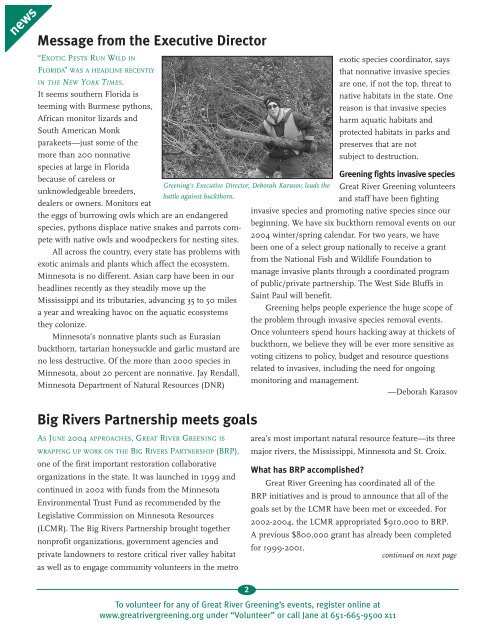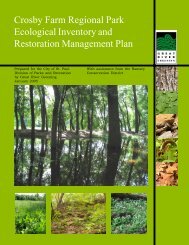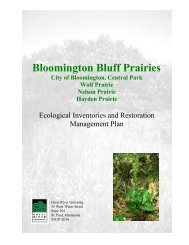Greening_Spring_04 - Great River Greening
Greening_Spring_04 - Great River Greening
Greening_Spring_04 - Great River Greening
Create successful ePaper yourself
Turn your PDF publications into a flip-book with our unique Google optimized e-Paper software.
news<br />
Message from the Executive Director<br />
“EXOTIC PESTS RUN WILD IN<br />
FLORIDA” WAS A HEADLINE RECENTLY<br />
IN THE NEW YORK TIMES.<br />
It seems southern Florida is<br />
teeming with Burmese pythons,<br />
African monitor lizards and<br />
South American Monk<br />
parakeets—just some of the<br />
more than 200 nonnative<br />
species at large in Florida<br />
because of careless or<br />
unknowledgeable breeders,<br />
battle against buckthorn.<br />
dealers or owners. Monitors eat<br />
the eggs of burrowing owls which are an endangered<br />
species, pythons displace native snakes and parrots compete<br />
with native owls and woodpeckers for nesting sites.<br />
All across the country, every state has problems with<br />
exotic animals and plants which affect the ecosystem.<br />
Minnesota is no different. Asian carp have been in our<br />
headlines recently as they steadily move up the<br />
Mississippi and its tributaries, advancing 35 to 50 miles<br />
a year and wreaking havoc on the aquatic ecosystems<br />
they colonize.<br />
Minnesota’s nonnative plants such as Eurasian<br />
buckthorn, tartarian honeysuckle and garlic mustard are<br />
no less destructive. Of the more than 2000 species in<br />
Minnesota, about 20 percent are nonnative. Jay Rendall,<br />
Minnesota Department of Natural Resources (DNR)<br />
<strong>Greening</strong>'s Executive Director, Deborah Karasov, leads the<br />
exotic species coordinator, says<br />
that nonnative invasive species<br />
are one, if not the top, threat to<br />
native habitats in the state. One<br />
reason is that invasive species<br />
harm aquatic habitats and<br />
protected habitats in parks and<br />
preserves that are not<br />
subject to destruction.<br />
<strong>Greening</strong> fights invasive species<br />
<strong>Great</strong> <strong>River</strong> <strong>Greening</strong> volunteers<br />
and staff have been fighting<br />
invasive species and promoting native species since our<br />
beginning. We have six buckthorn removal events on our<br />
20<strong>04</strong> winter/spring calendar. For two years, we have<br />
been one of a select group nationally to receive a grant<br />
from the National Fish and Wildlife Foundation to<br />
manage invasive plants through a coordinated program<br />
of public/private partnership. The West Side Bluffs in<br />
Saint Paul will benefit.<br />
<strong>Greening</strong> helps people experience the huge scope of<br />
the problem through invasive species removal events.<br />
Once volunteers spend hours hacking away at thickets of<br />
buckthorn, we believe they will be ever more sensitive as<br />
voting citizens to policy, budget and resource questions<br />
related to invasives, including the need for ongoing<br />
monitoring and management.<br />
—Deborah Karasov<br />
Big <strong>River</strong>s Partnership meets goals<br />
AS JUNE 20<strong>04</strong> APPROACHES, GREAT RIVER GREENING IS<br />
WRAPPING UP WORK ON THE BIG RIVERS PARTNERSHIP (BRP),<br />
one of the first important restoration collaborative<br />
organizations in the state. It was launched in 1999 and<br />
continued in 2002 with funds from the Minnesota<br />
Environmental Trust Fund as recommended by the<br />
Legislative Commission on Minnesota Resources<br />
(LCMR). The Big <strong>River</strong>s Partnership brought together<br />
nonprofit organizations, government agencies and<br />
private landowners to restore critical river valley habitat<br />
as well as to engage community volunteers in the metro<br />
area’s most important natural resource feature—its three<br />
major rivers, the Mississippi, Minnesota and St. Croix.<br />
What has BRP accomplished?<br />
<strong>Great</strong> <strong>River</strong> <strong>Greening</strong> has coordinated all of the<br />
BRP initiatives and is proud to announce that all of the<br />
goals set by the LCMR have been met or exceeded. For<br />
2002-20<strong>04</strong>, the LCMR appropriated $910,000 to BRP.<br />
A previous $800,000 grant has already been completed<br />
for 1999-2001.<br />
continued on next page<br />
2<br />
A PUBLICATION To volunteer for OF any GREAT of <strong>Great</strong> <strong>River</strong> RIVER <strong>Greening</strong>’s GREENING events, register online SPRING at 2002<br />
35 West Water Street, www.greatrivergreening.org Suite 201, Saint Paul, under Minnesota “Volunteer” 55107 or • 651-665-9500 call Jane at 651-665-9500 • www.greatrivergreening.org<br />
x11





